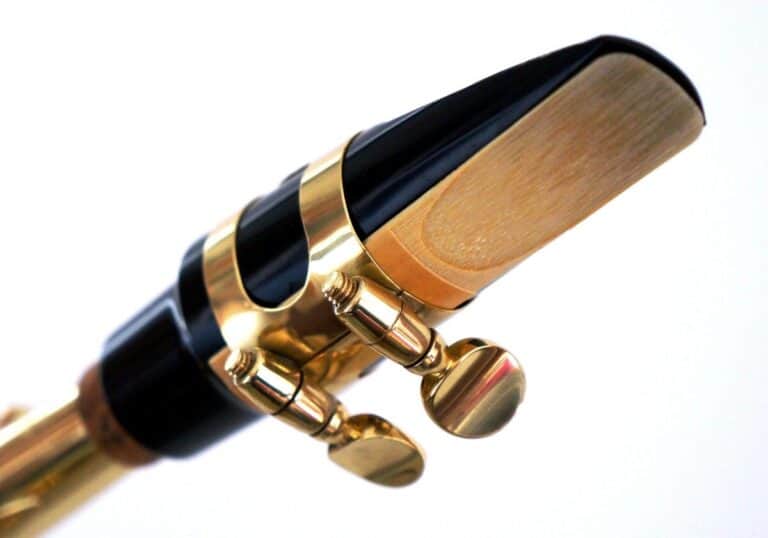Can I Put My Saxophone in the Dishwasher?
You’re probably looking for an easy way to deep clean your saxophone, and one of the options you considered is using your dishwasher. This is a clever idea, but unfortunately it also happens to be a terrible one.
Never put any part of your saxophone in the dishwasher. The high heat of a dishwasher will ruin the pads, damage the soft metals that saxophones are typically made of, and cause a hard rubber mouthpiece to melt. If your saxophone is brass, you also risk leaving toxic lead residue in your dishwasher.
I’m going to explain why putting your saxophone in the dishwasher is never something that should happen – ever. Then we’ll get into what exactly you can do instead.
Why you shouldn’t put your saxophone in the dishwasher
Essentially, the hot water that dishwashers use for cleaning is destructive to just about every part of the saxophone.
Let’s start with the pads. Pads tend to be easily damaged by water in general, and they will undoubtedly be completely destroyed if exposed to the scalding hot water of the dishwasher. If you were to wash your saxophone in the dishwasher, you would have to remove either all the keys or all the pads underneath the keys first.
Even so, the rest of the saxophone isn’t much better prepared to handle hot water than the pads are. Saxophones are typically made of brass or silver, and the dishwasher will almost certainly wear down lacquer and soft metals.
Brass also has a small amount of lead in it, and being exposed to hot water will cause a small amount of lead residue to be left behind. Lead is poisonous, and you probably don’t want it anywhere near the dishes and silverware that you use to eat.
For what it’s worth, dishwashers can also destroy many other parts of the saxophone such as the cork and mouthpiece, both of which are not meant to be exposed to high heat.
Ultimately, there just isn’t any way to clean your saxophone in the dishwasher without doing more harm than good. Even if your saxophone wasn’t brass, was unlacquered, and had all the pads removed beforehand, the cleaning environment of the dishwasher is simply too hot to ensure that you can avoid risk of damage.
Saxophones are much more fragile than dishes or silverware. So don’t put your saxophone in the dishwasher.
How to clean your saxophone instead
If your saxophone is especially dirty, you can take it to a trusted repair person for a deep cleaning, or attempt to do so yourself if you dare. Otherwise, regularly swabbing your saxophone several times after you play will suffice.
It is a rare occurrence that a saxophone becomes so dirty that it needs a deep cleaning. Usually, this is only necessary when the saxophone begins to smell bad or it is so filled with gunk that it becomes difficult to play. Most of the day-to-day maintenance that you should be doing on a saxophone is swabbing it after each time you play.
If you were considering putting your saxophone in the dishwasher, you are probably more interested in getting a deep-cleaning.
Deep cleaning
Unfortunately, deep cleaning a saxophone is not an easy task. You still have to remove all the keys and machinery of the instrument. As such, it should only be done when absolutely necessary.
Given that deep cleaning is a difficult task, I recommend leaving it in the hands of a professional. Find a repair person, preferably one who specializes in the saxophone.
If you feel that you absolutely must do it yourself (for financial reasons or otherwise), you can. Know that you will have to take apart your saxophone in the process, though, and you may struggle to put it back together again.
I personally am not experienced enough with this process to explain how to do it. However, I think that this video does an excellent job of it, and I recommend you study it well if you are serious about doing a deep-cleaning yourself.
Regular maintenance
Most of the time you shouldn’t need to deep clean your saxophone. Saxophones do need to be kept generally dry and have the saliva cleaned out of them, but usually just a simple pull-through swab is enough to get the job done.
If you do not already have a swab, you can find one here.
Just be sure to pull the swab through each part of your saxophone (mouthpiece, neck and body), after each time you play. Do this about three times for each part of the saxophone. As long as you do this consistently, your saxophone should never get to the point where you need to deep clean it.
If the mouthpiece becomes especially dirty, you can clean it with a mouthpiece brush, warm water, and some baby shampoo. Gently scrub with the mouthpiece brush; this should get most of the calcification off. If you scrub too hard, you could scratch the mouthpiece.
Finally, if you want to keep the pads protected (especially the G# and low C# key), you can buy some pad leaves and keep them underneath your keys when you aren’t playing.
The saxophone otherwise shouldn’t need particularly thorough regular maintenance (unless something becomes damaged), and it certainly doesn’t need to be put in the dishwasher.
Conclusion
Putting your saxophone in the dishwasher is a terrible idea, and it is something which you should never do. Thankfully, there are alternatives which are far less destructive.
I hope this article has thoroughly squelched the idea of putting your saxophone in the dishwasher, and helped you understand what to do instead.







